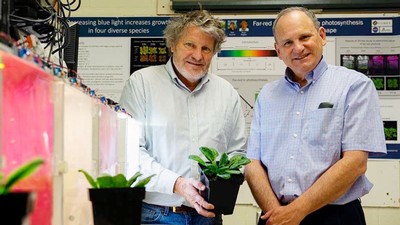Multi-Year Elementary School Study Moves to Online Delivery
By Allyson Myers |
Utah State University Emma Eccles Jones College of Education and Human Resources professors Ron and Sandi Gillam, along with their colleagues at the University of Texas at Austin, were conducting a $3 million, multi-year trial funded by the U.S. Department of Education (USDE) when elementary schools were closed across both states due to the coronavirus pandemic.
The study evaluates an instructional program to improve oral and written language skills in at-risk children in grades 1-4, and the school closures presented a significant challenge for the research team. After consultation with their project officer in the USDE and the chair of the USU Institutional Review Board, they decided to flip their assessment and instruction to online delivery and continue the project using distance learning technology.
With support from the Department of Communicative Disorders and Deaf Education, the Gillams rapidly and successfully converted the multi-year trial to online delivery, allowing them to continue bringing vital language services to at-risk children.
The inequities of internet access and devices to support online education have become more evident during this crisis; these inequities appear to especially affect students who are at-risk or who have diverse or special educational needs.
About 10 families either did not have devices or stable internet access to facilitate online instruction, so the researchers purchased 10 devices with data plans specifically for those families.
“We were really determined to make sure all of our students had equal opportunities to continue their participation in the study regardless of their financial circumstances,” said Sandi Gillam, adding that the team wanted to be sure to stay in line with the social distancing recommendations outlined by the governor.
With masks, gloves and materials in hand, members of the research team delivered the necessary materials.
“I specifically remember one parent, who smiled sweetly and waved at me from her window as I dropped off her materials,” Sandi Gillam said. “I stood there with my gloves and mask on, waving back. It brings tears to my eyes when I think about it.”
The research team led students through a week of “booster sessions” to help them review what they had learned and to work out kinks in schedules and technology, then resumed instruction where students had left off.
Instruction had previously been provided in groups, so the research team tried to maintain that dynamic when possible. Often, one teacher connected with three families to conduct the instructional sessions. Nikki Rice, one of the teachers working with the project, said that some of her favorite moments involved talking with one or two students while waiting for the last one to arrive.
“The students seemed so happy to see me, and I was very happy to see them,” said Rice.
Lindsay Dutson, another instructor, said that being part of students’ home life was valuable to her.
“I met nearly all the brothers and sisters of all of my students, not to mention almost all of their parents, too,” Dutson said. “It was so fun to get to know another side of these kids and their family dynamics.”
The sessions did not always go off without a hitch. Sometimes Zoom videos turned upside down, family members danced in the background or parents had to be texted or called to deal with off-task behaviors. Overall, however, the students were engaged and worked hard, aided by their parents.
“The parents were simply amazing at helping their students attend and participate in the instruction to improve their language abilities,” said Beula Magimairaj, the research coordinator.
Ron Gillam, project director, spoke of the importance of arranging to continue studies such as these.
“These children really needed some educational continuity during this crazy time,” he said. “Our research teams in Utah and in Texas really rose to the occasion to do something that was helpful and enriching to the at-risk students in our study.”
All students completed the specialized instruction by mid-May, and the research team plans to analyze the COVID-19 influenced data and compare it to other data that has been collected during the previous two years.
Learn more about the ways that COVID-19 is impacting clinical trials nationwide.
WRITER
Allyson Myers
Public Relations and Marketing Assistant
Emma Eccles Jones College of Education and Human Services
allyson.myers@usu.edu
CONTACT
Rebecca Dixon
Director, Public Relations and Marketing
Emma Eccles Jones College of Education and Human Services
435-797-1463
rebecca.dixon@usu.edu
TOPICS
Research 881stories Education 335stories Technology 141stories K-12 75stories Partnerships 58stories Online Education 44storiesComments and questions regarding this article may be directed to the contact person listed on this page.









